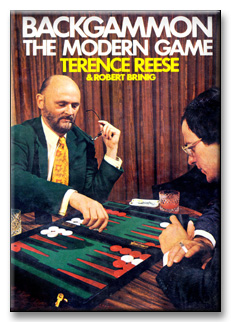
|
Backgammon Books |
 |
|||||||
| Backgammon The Modern Game | |||||||
 |
|||||||
| AUTHORS: | Terence Reese Robert Brinig |
||||||
| YEAR: | 1975 |
||||||
| PUBLISHER: | W. H. Allen & Co. Ltd. |
||||||
| CITY: | London |
||||||
| ISBN: | 0-491-01663-8 |
||||||
| BINDING: | Hardcover |
||||||
| PAGES: | 139 |
||||||
| SIZE: | 24 cm high, 16 cm wide |
||||||
| NOTE: |
Jacket photograph of Terence Reese (left) and Robert Brinig (right) by Mark Gudgeon. |
||||||
|
OTHER EDITIONS: |
Softcover, 1977 |
||||||
| CONTENTS: |
|
||||||
| COVER: |
Backgammon is a great game — easy to learn, fast, exciting, a perfect blend of chance and skill. It must possess remarkable qualities to have lasted for three thousand years. Why, then, "the modern game"? For two reasons: firstly, it has become tremendously popular; secondly, new ideas have made it almost a new game. A number of books have analysed the opening moves, described a few specimen games and sent the reader on his way, knowing how the game is played but with little idea how to play it. Readers of Terence Reese's famous books on bridge will expect — and find — a much deeper study. The first chapter is for beginners; from then on, the reader gains an insight into the different elements of the game so that he can think for himself in all situations. The middle chapters include concepts that have always been in the mid of expert players but have never before been formulated in writing. Mr Reese's co-author, Robert Brinig, a former lecturer in English at Berkeley University, has been a champion backgammon player for fifteen years. Together they have produced a book that will enormously increase the ability — not to mention the profit — of all who read it. |
||||||
|
ABOUT THE AUTHORS: |
Although his greatest reputation is in the field of bridge, Terence Reese has also written outstanding books on poker and canasta. Like many of the top bridge players, he took to backgammon at once and plays regularly at the Clermont Club in London, the game's headquarters. He writes a backgammon feature for The Lady and directs bridge and backgammon cruises on the P & O liner, Canberra. In addition to the games mentioned above. Mr Reese plays chess, golf and snooker, follows greyhound racing and is an enthusiastic supporter of Queen's Park Rangers.
Robert Brinig is a former lecturer in English at Berkeley University and has been a champion backgammon player for fifteen years. |
||||||
 |
|||||||
 
|
|
 
|
||||||
|
Copyright © 1996-2016 by Tom Keith
| ||||||||
